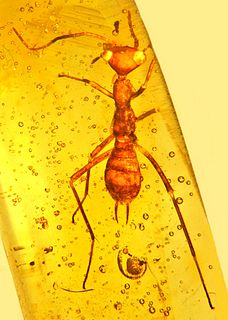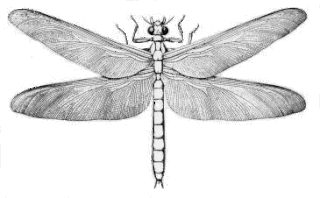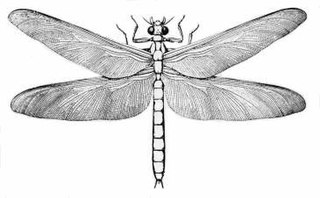 W
WAethiocarenus is an extinct genus of insects which has a single species Aethiocarenus burmanicus described from a 98.79 ±0.62 million year old fossil found in Burmese amber from the Hukawng Valley of Myanmar. The insect is unusual due to the vertex of the triangular head being attached to the pronotum as opposed to the hypotenuse. When first described Aethiocarenus was placed as the sole member of the family Aethiocarenidae and order Aethiocarenodea. However, Aethiocarenus was later considered to be a nymph of Alienopterus. Vršanský et al. (2018) considered Aethiocarenus to be an alienopterid nymph, but considered it distinct from other members of this group and deserving a separate genus rank.
 W
WThe Odonatoptera are a superorder of ancient winged insects, placed in the Palaeoptera which probably form a paraphyletic group however. The dragonflies and damselflies are the only living members of this group, which was far more diverse in the late Paleozoic and contained gigantic species, including the griffinflies of the order Protodonata. This lineage dates back at least to the Bashkirian, not quite 320 million years ago.
 W
WCoxoplectoptera or "chimera wings" is a primitive, extinct order of winged insects containing one family, Mickoleitiidae, discovered in 2007.
 W
WThe Odonatoptera are a superorder of ancient winged insects, placed in the Palaeoptera which probably form a paraphyletic group however. The dragonflies and damselflies are the only living members of this group, which was far more diverse in the late Paleozoic and contained gigantic species, including the griffinflies of the order Protodonata. This lineage dates back at least to the Bashkirian, not quite 320 million years ago.
 W
WMeganisoptera is an extinct order of very large to gigantic insects, occasionally called griffinflies. The order was formerly named Protodonata, the "proto-Odonata", for their similar appearance and supposed relation to modern Odonata. They range in Palaeozoic times. Though most were only slightly larger than modern dragonflies, the order includes the largest known insect species, such as the late Carboniferous Meganeura monyi, Megatypus, and the even larger early Permian Meganeuropsis permiana, with wingspans of up to 71 centimetres (28 in).
 W
WThe Palaeodictyoptera are an extinct order of medium-sized to very large, primitive Palaeozoic paleopterous insects.
 W
WPermopsocida is an extinct order of insects known from the Early Permian to Mid-Cretaceous. It is part of Paraneoptera, alongside bark lice, bugs and thrips. Within Paraneoptera it is considered to be closer to the clade containing bugs and thrips rather than bark lice, with an estimated divergence during the Late Carboniferous. The group was first named as a suborder by Robert John Tillyard in 1926, and was raised to a full order by Huang et al. in 2016. It is currently divided up into three families, Psocidiidae which is known from the Permian to Liassic. Permopsocidae which is only known from the Permian, and Archipsyllidae, which is known from the Late Triassic to mid-Cretaceous (Cenomanian). While most members of the group are known from compression fossils, several members of Archipsyllidae are 3 dimensionally preserved in Burmese amber, which has helped clarify the morphology and phyogenetic position of the group. The morphology of the mouthparts suggests that they were capable of suction feeding and chewing, with preserved angiosperm pollen grains in the gut of Psocorrhyncha suggesting that at least some members of the group were pollenivorous.
 W
WThe Odonatoptera are a superorder of ancient winged insects, placed in the Palaeoptera which probably form a paraphyletic group however. The dragonflies and damselflies are the only living members of this group, which was far more diverse in the late Paleozoic and contained gigantic species, including the griffinflies of the order Protodonata. This lineage dates back at least to the Bashkirian, not quite 320 million years ago.
 W
WProtelytroptera is an extinct order of insects thought to be a stem group from which the modern Dermaptera evolved. These insects, which resemble modern Blattodea, or Cockroaches, are known from the Permian of North America, Europe and Australia, from the fossils of their shell-like forewings and the large, unequal, anal fan. None of their fossils are known from the Triassic when the morphological changes from Protelytroptera to Dermaptera presumably took place.
 W
WThe Protorthoptera are an extinct order of Palaeozoic insects, and represent a wastebasket taxon and paraphyletic assemblage of basal neoptera. They appear during the Middle Carboniferous, making them among the earliest known winged insects in the fossil record. Pronotal lobes may be expanded to form a shield. The group includes the ancestors of all other polyneopterous insects.
 W
WThe Odonatoptera are a superorder of ancient winged insects, placed in the Palaeoptera which probably form a paraphyletic group however. The dragonflies and damselflies are the only living members of this group, which was far more diverse in the late Paleozoic and contained gigantic species, including the griffinflies of the order Protodonata. This lineage dates back at least to the Bashkirian, not quite 320 million years ago.
 W
WTarachoptera is an extinct order of insects, currently solely known from the mid Cretaceous aged Burmese amber. It belongs to Amphiesmenoptera alongside living Lepidopterans and Trichoptera (caddiesflies), but is outside the clade containing the two groups, with an estimated divergence during the Upper Triassic, and therefore over a 100 million year ghost lineage. It currently contains only one family, the Tarachocelidae, which was named in a publication in 2017 a few months before the order itself was published. As the manuscript was in submission, an additional specimen belonging to a new genus justified creating a separate order. Additional species were described in 2018 and 2020. A notable character is the possession of wing scales like members of Lepidoptera, but these were suggested to have been evolved in parallel evolution from hairs or setae. Their flattened morphology and small size suggests they were adapted to living in small crevaces, the morphology of the mouth suggests that they were phytophagous, and ingested small particles, perhaps including pollen grains.
 W
WThe Tarsophlebiidae is an extinct family of medium-sized fossil odonates from the Upper Jurassic and Lower Cretaceous period of Eurasia. They are either the most basal member of the damsel-dragonfly grade ("anisozygopteres") within the stem group of Anisoptera, or the sister group of all Recent odonates. They are characterized by the basally open discoidal cell in both pairs of wings, very long legs, paddle-shaped male cerci, and a hypertrophied ovipositor in females.
 W
WTitanoptera is an extinct order of neopteran insects from the Triassic period. Titanopterans were very large in comparison with modern insects, some having wingspans of up to 36 centimetres (14 in).
 W
WThe Odonatoptera are a superorder of ancient winged insects, placed in the Palaeoptera which probably form a paraphyletic group however. The dragonflies and damselflies are the only living members of this group, which was far more diverse in the late Paleozoic and contained gigantic species, including the griffinflies of the order Protodonata. This lineage dates back at least to the Bashkirian, not quite 320 million years ago.